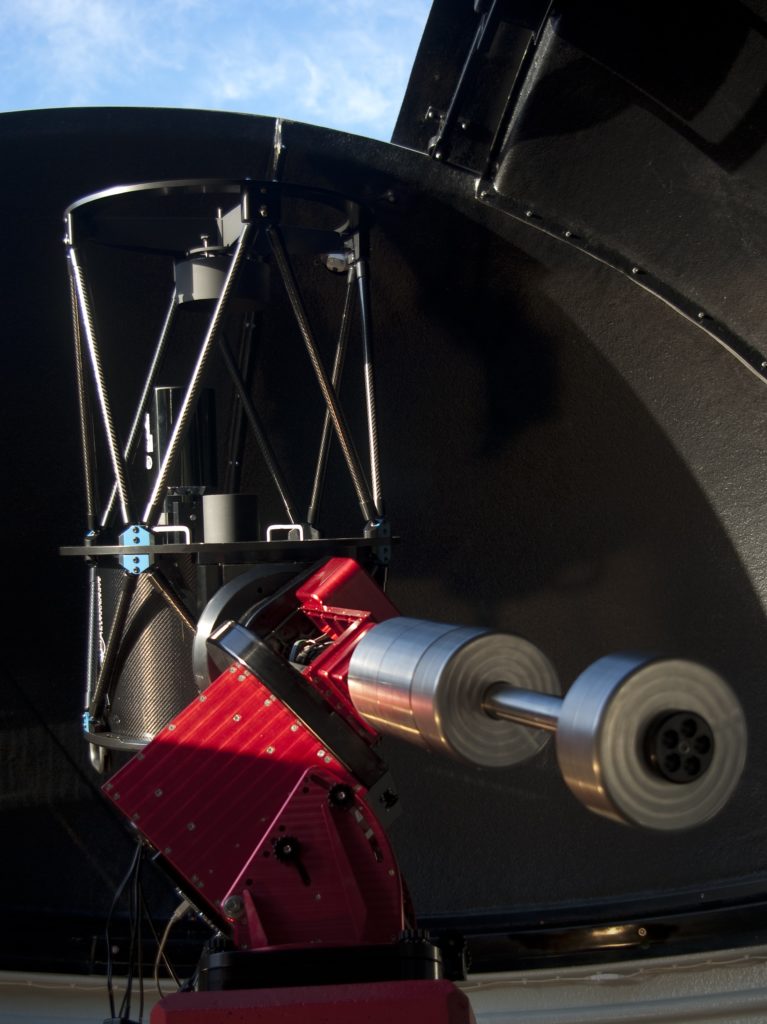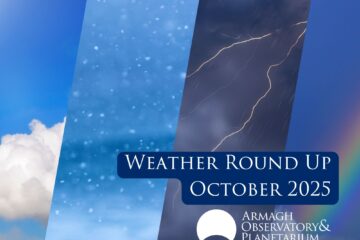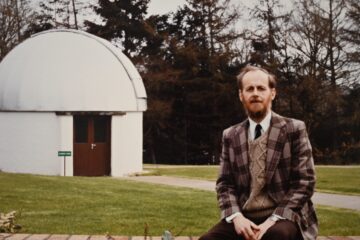The Armagh Robotic Telescope (ART) is the youngest, and most advanced, telescope housed at the Armagh Observatory and Planetarium (AOP).
It has been 10 years since first light was achieved, and we would like to take this opportunity to talk to the man behind the telescope. Professor Simon Jeffery has been a resident astronomer with the AOP for many years, and specialises in Heavy Metal Stars, Born Again stars, and much more. We would like to thank him for taking the time to answer our burning questions!
1. Where did the idea for ART originate?
In December 2009, the previous director, Mark Bailey, and I were brainstorming for new projects, and identified the need for a versatile modern telescope to which we could attach a scientific instrument. We particularly wanted to show that Armagh Observatory was still capable of making modern astronomical observations in the 21st century, more than 200 years after it was founded.
2. What was the spark that ignited the need for the ART?
We had been monitoring a small patch of sky with the Polar Bear Telescope for a number of years. We realised that Armagh had no significant telescope which we could use to observe a significant event elsewhere in the sky, or to provide hands-on training for our students. At the same time, developments in the amateur astronomy market meant that research-grade equipment was available at “Off-the-shelf” prices.
 The Armagh Robotic Telescope. Credit: Professor Simon Jeffery/AOP
The Armagh Robotic Telescope. Credit: Professor Simon Jeffery/AOP
3. How long did it take to get the ART project up and running?
We purchased the main part of the telescope – the optical tube assembly – in early 2009. Over the following year we ordered the mount and the dome. Construction of the dome was completed in July 2010, and we obtained first light in February 2011. The formal opening took place on 4th March 2011, but a lot of work went on after that to enable smooth and remote operations.
4. Were there any hurdles that slowed the process?
Of course there were several, … but sometimes that meant winning more time to think through options more carefully. The decision to upscale the original project cost by a factor 5 necessitated a delay into a new financial year to get the necessary approvals. When the contractors arrived on site they discovered they had to build a temporary road in order to crane in the telescope pier and pour concrete. “Simon’s road” is now the well-drained grass pathway running from Robinson Drive to the ART along the edge of the woodland. This put the costs up by 8% and wiped out the reserve and the computer budget. But the biggest delay was caused by a missing adapter to connect the camera to the telescope. Several frustrating weeks were lost during winter 2010/11 when everything else was ready to go, but we just couldn’t get “First Light”.
5. Why is the telescope smaller in physical size, when compared to the other historic telescopes at AOP?
Two things are smaller, the telescope, and the dome. We’ll come to those in a moment. The most important feature of a telescope is its light gathering power, which is determined by its APERTURE. The ART has a 43 cm diameter mirror (17 inches in old money), larger than the 38 cm metal mirror of the 1835 Grubb and the 25 cm lens of the 1885 Grubb, but marginally smaller than the 46 cm mirror of the Calver telescope installed in 1918.
Being a reflecting telescope makes it both more efficient than a refractor AND allows the optics to be folded. By using correcting optics, modern telescope mirrors can be manufactured accurately with much shorter focal lengths than were possible 100 and 200 years ago. At f/6.8 the ART is relatively “fast” and the length of the telescope can be reduced to less than 1.1 m, compared with nearly 2 – 4 m for the other large Armagh telescopes.
Once the length of the telescope is reduced, its weight is also reduced, and everything else can be made more compact. So even though the telescope is the most powerful in Armagh, its enclosure is also the smallest.
 Credit: Professor Simon Jeffery/AOP
Credit: Professor Simon Jeffery/AOP
6. How does the telescope work?
The telescope consists of two mirrors and a set of auxiliary lenses. The 43 cm ellipsoidal main mirror reflects light up toward a smaller secondary mirror. This is in turn reflects the light back down through a chimney in the centre of the main mirror. This chimney contains a set of refocusing lenses which ensure crisp images in all colours across the entire field of view. The image is focused onto a detector known as a charge-coupled device (or CCD). This is similar to the sensor found in most modern cameras – but much more sensitive. We use a monochrome (black-and-white) sensor rather than a colour sensor. To make colour images we use filters to take images in red light, green light and blue light, and then mix them together.
7. How is it different to the other telescopes at AOP?
As we mentioned already, most of the other AOP telescopes are refractors … they use lenses to focus the light. The 50 cm Calver is a reflector, but with mechanics over 100 years old it cannot point and track accurately.
The main thing that makes ART different from other Armagh telescopes is that it is driven entirely from a computer and, since computers can be operated from anywhere, the astronomer can make use of clear skies at any time of night – without having to travel into the observatory to observe. When programmed correctly, the telescope can be completely automated. The astronomer would submit a list of instructions at the beginning of the night, and next morning find the data ready for analysis.
Another thing to be done is to run public observing sessions from a classroom or the planetarium dome, or even from people’s own homes. The ART was designed exactly with this purpose in mind.
8. What was the first object observed through the ART, and when did this happen?
First Light was obtained in 1 February 2011. We started with the Pleiades (Messier 45), a cluster of bright stars easily visible with the naked eye. We also photographed the great nebula in Andromeda (M31), the Bubble nebula (NGC 7635) and another cluster M103.
9. Technology has advanced a lot in 10 years; will the ART get upgrades as technology advances?
We have already replaced the camera once with one that is nearly twice as sensitive as the original, though at some cost to image area. Hopefully we will be able to continue to upgrade the camera as funds allow.
A modern telescope system has a lot of different systems, including those that open and rotate the dome, those that point and guide the telescope, and those that collect and process the images. All of these need regular maintenance and modernisation and we have just started a major upgrade of all the control systems.
10. What is your favourite memory of the ART, so far?
There have been many memorable moments. In the early days, when the dome arrived, all of the students came out to help unpack the shipping container, carry the pieces up the hill, and help assemble them. It was another Herculean team effort to hoist the telescope tube onto its mount.
For me, who started his career as a theoretician, and only later learnt how to observe, the official opening was a proud moment. Jack Wright had set things up so that the Minister’s representative – Alastair Hughes – could open and rotate the dome and slew the telescope at the touch of a single button. BBC journalist Gordon Adair made a superb film of the dome and telescope slewing in the evening Sun.
On another occasion it was a privilege to take President Michael D. Higgins and Sabina Higgins into the dome and show them the telescope. They are really lovely people!
However, my favourite memory was one long clear run when I was able to operate the telescope from home. We were monitoring oscillations in a variable star and observations started in the early evening. I had to reverse the telescope around midnight, realigned the star on the target, and went to bed for a good night’s sleep. In the morning, the dome was all nicely closed, the telescope parked, and the data all ready for analysis. Hopefully, I and others will be able to do this more often in the future.
 Professor Simon Jeffery explaining the ART to Irish President Michael D. Higgins , his wife, Sabina Higgins and the Archibishop of Armagh. Credit: Professor Simon Jeffery/AOP
Professor Simon Jeffery explaining the ART to Irish President Michael D. Higgins , his wife, Sabina Higgins and the Archibishop of Armagh. Credit: Professor Simon Jeffery/AOP
11. Who have been the key players in the ART project.
First of all, this was a project that former director Mark Bailey was really enthusiastic about, and he provided the motivation to get things started. His enthusiasm also brought our sponsor body – the Northern Ireland Department for Culture, Arts and Leisure – fully on board so that a very modest idea could be transformed into a highly professional research tool with potential for public education. Simon Bennett of The Widescreen Centre was the principal supply contractor and his knowledge of the market proved invaluable in guiding the initial design.
Our former electronics engineer Geoff Coxhead was key to getting the dome wired and making the telescope and dome electrically and mechanically functional. Jack Wright, a gap year student came on board for six months to help with commissioning, from configuring the software through to obtaining First Light. His notes and tutorials are the main ART “How To” resource. He is now a postdoctoral researcher at the Open University. Rebecca Feeney-Barry, a Trinity College Dublin student, did an outstanding final year project in which she made several nights of observations, wrote the ART data reduction pipeline and presented a poster paper on oscillations in a hot subdwarf in the space of a few short weeks. In recent years, technician James Finnegan provided trouble shooting support, and assisted astronomer Tolis Christou to make many solar-system observations which led to refereed publications in astronomical journals.
12. What are your future research plans, and will ART be involved in any way?
One of my research interests is the variability of evolved stars. In many cases, observations from space or from survey telescopes at high-altitude observatories have overtaken what we can do with ART. However there are stars which will not be easily observed by such missions, and there is always a place for telescope like the ART. The next Jovian mutual events season will occur later this year, and we should always be ready to observe occasional occultations of bright stars by asteroids, and many other transient astronomical events. The key to making ART really successful is to make it ready to go whenever the weather is good – without waiting for an astronomer to be available. Then it will truly be the Armagh ROBOTIC Telescope.



0 Comments